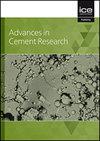剑麻纤维处理对水泥生物复合材料水化及热物理性能的影响
IF 1.3
4区 工程技术
Q3 CONSTRUCTION & BUILDING TECHNOLOGY
引用次数: 0
摘要
水泥基生物复合材料是当前建筑研究的一个领域。由于植物纤维的亲水性,它们延缓了水泥的凝结时间,并且含有植物纤维的生水泥砂浆的热性能可能会出现问题。这项工作的目的是研究纤维处理的影响,以降低天然纤维的亲水性,同时提高胶凝基质的热性能。本研究的第一部分侧重于结构和形态方面。扫描电镜观察发现,经氢氧化钠和石蜡油处理的剑麻纤维粘附表面有一层细小的钙层环绕。傅里叶变换红外光谱显示碳酸钙和氢氧化钙的吸收带峰不一致。该处理减缓了界面过渡区纤维细胞壁的碱性水解和矿化,从而促进了水泥的水化。本工作的第二部分是对复合材料的热物理研究。剑麻纤维的加入导致了导热性和热容的显著降低。结果表明,剑麻纤维在石蜡油中的热性能最好。因此,从绝缘的角度来看,用处理过的剑麻纤维制成的生物砂浆很有前途。本文章由计算机程序翻译,如有差异,请以英文原文为准。
Effect of Sisal fiber's treatment on hydration and thermophysical properties of cement biocomposite
Cement-based biocomposites are a current area of construction research. Plant fibres retard the setting times of cement due to their hydrophilic nature and the thermal properties of raw cement mortar containing plant fibres can be problematic. This aim of this work was to study the effect of fibre treatment to reduce the hydrophilicity of natural fibres while enhancing the thermal properties of the cementitious matrix. The first part of this study focused on structural and morphological aspects. Scanning electron microscopy showed a tiny calcium layer around the sisal fibre treated with sodium hydroxide and paraffin oil on the adhesion surface. Fourier transform infrared spectroscopy revealed a disparity in the peaks of the absorption bands of calcium carbonate and calcium hydroxide. The treatment slowed the alkaline hydrolysis and mineralisation of the fibre cell walls in the interfacial transition zone, thus promoting cement hydration. The second part of this work was a thermophysical study of the composites. The inclusion of sisal fibres led to remarkable decreases in thermal conductivity and heat capacity. The best thermal properties were obtained for the composite with sisal fibre immersed in paraffin oil. Biomortars with treated sisal fibre are thus promising from an insulation point of view.
求助全文
通过发布文献求助,成功后即可免费获取论文全文。
去求助
来源期刊

Advances in Cement Research
工程技术-材料科学:综合
CiteScore
3.70
自引率
5.00%
发文量
56
审稿时长
3.2 months
期刊介绍:
Advances in Cement Research highlights the scientific ideas and innovations within the cutting-edge cement manufacture industry. It is a global journal with a scope encompassing cement manufacture and materials, properties and durability of cementitious materials and systems, hydration, interaction of cement with other materials, analysis and testing, special cements and applications.
 求助内容:
求助内容: 应助结果提醒方式:
应助结果提醒方式:


